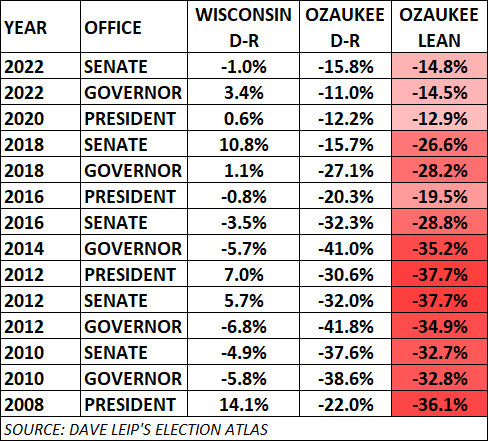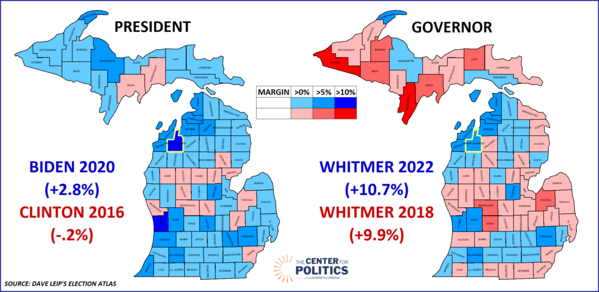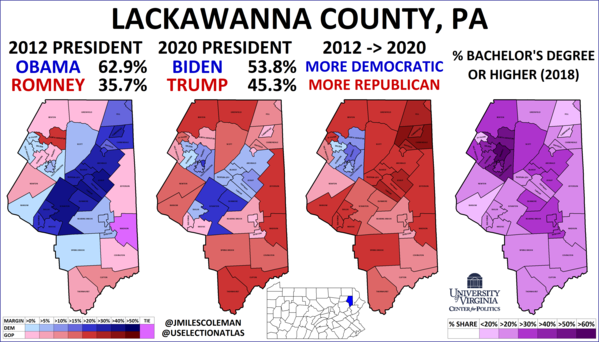Places to Watch, Part One: The Industrial North
A Commentary By J. Miles Coleman
KEY POINTS FROM THIS ARTICLE
— While the 7 Toss-up states on our current Electoral College map will have outsized importance nationally, each of those states has several key counties that we will be watching.
— In this article, we’ll be isolating a few counties from the “Blue Wall” states that could tell the tale of the 2024 election.
— In Wisconsin, Ozaukee County is the bluest of the “WOW” counties while Door County has been a great bellwether in recent cycles.
— To win back Michigan, Donald Trump would probably like to flip back Saginaw County and keep the Cherry Coast red.
— In Pennsylvania, Kamala Harris may be poised to narrow Trump’s margin in Cumberland County, although we are curious how she’ll fare in Joe Biden’s native Lackawanna County.
Key counties in key states
One of the questions we are asked most often in emails and in discussions is which counties we’ll be watching when the results start to pour in on Election Night. These counties aren’t just “bellwethers” that we expect to vote for the winner; they also are places that have been trending one way or the other and might tell us something more broadly about the trajectory of the election, even if the counties themselves are not truly up for grabs.
On our current Electoral College map, we have 7 states identified as Toss-ups. Just sticking to these states, we’ve planned a two-part series isolating a few counties from each. Today’s focus will be on the three “Blue Wall” states; though they all have similar topline trajectories—after giving Barack Obama relatively comfortable margins, they each narrowly backed Donald Trump in 2016 before barely returning to the Democratic column with Joe Biden in 2020—the counties that follow are meant to illustrate some diverging trends.
For this, we wanted to avoid only highlighting the largest counties in each state that tend to get the most attention. In Pennsylvania, for instance, will Philadelphia be important? Yes, of course. In fact, despite its deep blue image, in 2020, Biden actually performed 4 points worse there than Hillary Clinton did in 2016—his gains elsewhere were enough to offset it, but if the city sees another similar rightward lurch, it could be enough to push the state out of reach for Harris. But, aside from those large localities, there will almost certainly be smaller counties around the nation that will inform the result.
And, to emphasize something we alluded to earlier: although we are including some in this piece, we are not relying too heavily on bellwether counties. This is partly because bellwethers are bellwethers until, well, they aren’t anymore. In Wisconsin, Buffalo County, a small county on the western border with Minnesota, voted with the state winner of every federal and gubernatorial race from 2000 to 2016. Then, starting in 2018, Democrats began to win statewide without it. There have been many such cases in the Trump era, as educational realignment has pushed counties like Buffalo to the right.
In any case, here are some of the counties we’ll be watching:
Wisconsin
Situated along Lake Michigan, Ozaukee County is just north of Milwaukee, which was the scene of this year’s Republican National Convention. While it puts the “O” in what has become known as the “WOW Counties,” it is also the least Republican of those three red counties—the others are Waukesha, which is the largest suburban county in Milwaukee’s orbit, and Washington, which is the reddest and most exurban of the trio.
In 2020, as Biden continued to slump in most of the Obama-to-Trump counties outside of metro Wisconsin, his performance in the Milwaukee suburbs arguably put him over the top in the state. Aside from Madison’s Dane County, Ozaukee County is the only other Wisconsin county where a majority of residents aged 25 years and older hold a college degree, according to census data provided by Redistricter. Though Biden still lost the county by a dozen points, his 43% here represented the highest share for a Democratic nominee since John F. Kennedy’s 41% in 1960 (its population has more than doubled since then, so it was, in some ways, an entirely different county).
Table 1 considers every presidential, senatorial, and gubernatorial race in Wisconsin since 2008. Compared to the state, Ozaukee County has become less red. After starting as a county that leaned more than 30 points right of the state, in the three most recent races on Table 1, it was within 15 points of the statewide vote.
Table 1: Ozaukee County lean in elections, 2008-2022
Note: Table 1 considers two-party totals.
Given its educational attainment level, this strikes us as the type of place where Trump’s margin may decline further. If Harris can limit Trump to a single-digit margin here, that would bode well for her statewide prospects.
If we’re watching Ozaukee County for its margin—even on a strong night for Harris, Trump will likely still carry it—we would flag Door County as a bellwether county. Door County, which makes up the likewise-named peninsula jutting into Lake Michigan, has tracked close with the statewide vote in presidential elections since 2008. In 2022, every statewide winner carried it. While Door County is not an especially large treasure trove of votes—in 2020, 40 counties cast more votes—its mix of wealthier coastal communities and conservative rural towns have given it a partisan mix that reflects the state well.
Michigan
In 2020, as Biden put Michigan back into the Democratic column, he improved over Hillary Clinton’s performance in most of the state’s large metro counties. However, one of the most notable trends north of the state’s major population centers was Biden’s improvement in the northeastern part of the lower peninsula. A handful of counties that make up the state’s “Cherry Coast”—named for the fruit it produces—each shifted more than 5 points to Biden. The most populous of this group is Grand Traverse County (Traverse City).
Like much of western Michigan overall, this is one of those areas that has been Republican for decades: the last two times that Grand Traverse County voted Democratic were also the party’s two most recent mega-landslides, 1936 and then 1964. Though Biden still lost the county, he matched the 3-point deficit that Obama posted there in 2008, even as he performed almost 14 points worse statewide.
On the surface, it seemed possible that, in 2020, the Cherry Coast’s pro-Democratic movement could have been something of a “one-time” deal: in this touristy area, it would have been easy to see voters being frustrated over Trump’s handling of the COVID pandemic (the aforementioned Door County in Wisconsin is also a “touristy” kind of place). But recent gubernatorial races suggest a more sustained shift. In 2018, though she narrowly lost it, Grand Traverse County saw the biggest swing to now-Gov. Gretchen Whitmer (D) of any non-metro county. In 2022, Whitmer improved her statewide margin by about a point but carried Grand Traverse County 52%-46%, which represented an 8% swing in her direction—it was her third-largest improvement of any county that year (the second largest came in nearby Emmet County).
Map 1 illustrates what we are getting at here. The right image shows the change between the two most recent presidential contests in Michigan and the left image shows the change between the 2018 and 2022 gubernatorial races. Grand Traverse County is outlined in gold. On the presidential map, it was one of two counties—along with Ottawa County, which has behaved similarly to counties like Ozaukee, WI in recent elections—that saw a double-digit two-party swing to Biden in 2020. In 2022, most coastal counties in its vicinity swung more than 5 points to Whitmer.
Map 1: Change in recent Michigan presidential and gubernatorial races
Note: Map 1 considers two-party totals.
While we don’t think Harris would have to carry Grand Traverse County to win Michigan—it was still about 6% more Republican than the state as a whole in 2020, and 4% more so in 2022—Democrats would probably like to at least limit Trump to a plurality there this year (in 2020, he took 50.5% of the vote against Biden and minor party candidates).
After we selected the counties for this article and were writing this up, we noticed that the Trump campaign dispatched JD Vance to Grand Traverse County yesterday—so maybe we are on to something with our list!
Moving east, the only county that has voted with the state in all four presidential elections since 2008 is Saginaw. An old industrial area, it has a higher Black population than Michigan as a whole—18%, compared to 12%—but is much more working class than Grand Traverse. After giving Obama double-digit margins in both of his runs, Trump carried Saginaw County by just over a percentage point, and Biden reclaimed it by about three-tenths of a point.
Given its status as the state’s lone recent presidential bellwether, we thought it merited inclusion here, although, as with the Buffalo County example given in the introduction, this could be a case of a county being predictive until it isn’t. Though Biden flipped it in 2020, Saginaw County was still just over 2 points right of the state. If Harris carries Michigan by a narrow margin, it would not be hard to see her losing it, although if Trump carries it, it may be a sign that his support in blue-collar communities is matching or exceeding what he got in his last two campaigns. Down the ballot, Saginaw County is also entirely located within Michigan’s 8th District, an open-seat race the Crystal Ball rates as a Toss-up. In 2022, Republican Paul Junge, who is again the GOP’s nominee, lost by just over 10 points districtwide to now-retiring Rep. Dan Kildee (D). Junge came a little closer in Saginaw County, losing it 51%-45%, so carrying it would probably be a necessary, but not sufficient, ingredient to a Republican flip in MI-8 this year.
Pennsylvania
As with Michigan, we are watching a pair of counties that are situated outside of the state’s major metro centers and are trending, at least over the long term, in opposite directions.
Though it got more buzz in 2020, considering one of its natives led a national ticket, Joe Biden’s native Lackawanna County will remain on our radar. During his time campaigning on the national stage, Biden has frequently referenced his upbringing in Scranton, the county’s largest city, when trying to relate to middle class voters.
Given its blue-collar character, Lackawanna saw a significant redshift from 2012 to 2016: after giving Obama a nearly 30-point margin in 2012, Hillary Clinton claimed only a 49.8% plurality there. Four years later, Biden clawed back several percentage points, but his 54%-45% vote there was weaker than what recent pre-Trump era Democratic nominees got. Still, since the 2020 results came in, we wondered how Lackawanna County would have looked if Democrats had not nominated Biden. From 2008 to 2016, Lackawanna County tracked almost perfectly with Mahoning County, Ohio—the home of Youngstown, it is another blue-collar area that has been hit by deindustrialization. After losing Mahoning County by 3 points in 2016, Trump flipped it 50%-48%. While we doubt the difference would have been that large, we could have seen a non-Biden Democrat faring at least a little worse in Lackawanna County.
While realignment has begun to take hold down the ballot—in 2022, for example, now-Gov. Josh Shapiro (D) won by nearly 15 points but fell a bit short of matching Obama’s 2012 margin in Lackawanna County—not all of Lackawanna County has trended hard against Democrats. Map 2 shows how educational realignment has affected the county since Obama’s elections. A handful of wealthier towns (that also have higher educational attainment levels) have mitigated the overall pro-Republican trend to some degree.
Map 2: 2012 – 2020 in Lackawanna County, PA
Overall, we would probably expect Harris’s margin in Lackawanna County to be somewhere in between Clinton’s and Biden’s if she were to be on track to carry the state.
Following the Susquehanna River southward, Cumberland County, one of the state’s fastest-growing counties outside of the Philadelphia metro area, has seen the opposite political trend. While it is still a basically Republican county, its lean, relative to the state as a whole, has become less pronounced over the past decade. In 2008, Cumberland County was nearly 25 points more Republican than Pennsylvania overall—Obama carried the state by 10 points but lost the county by 14 points. As Biden narrowly won Pennsylvania in 2020, he nearly got within single digits in Cumberland County, losing it by 10.5%.
The pro-Democratic trend in the county has mostly been fueled by its eastern communities that bump up against the state capital in Harrisburg. Carlisle, the centrally-located county seat, has similarly seen an influx of non-Pennsylvania natives moving in. While the county’s western towns are still overwhelmingly Republican, Harris likely has room to improve on Biden’s topline margin from 2020. Though both Democrats carried the county, Shapiro performed about 5 points better there in 2022 than now-former Gov. Tom Wolf (D) did in 2018—while each won comfortably statewide, Wolf did a few points better overall.
As with Lackawanna, we aren’t expecting Cumberland County to actually switch sides this year, but it could be informative from a directional perspective. If it remains stagnant, that would bode well for Trump, while the Harris campaign would probably like to hold Trump’s margin within single digits.
We’d also note that, as with Saginaw County and MI-8, both of our Pennsylvania counties are seeing competitive House races. In the northeast, Lackawanna County has been key to Rep. Matt Cartwright’s (D, PA-8) continued electoral success in an Obama-to-Trump seat. In both 2020 and 2022, he took about 59% in Lackawanna, so he seems likely to outrun Harris there. The current PA-10, held by Republican Scott Perry (R) and encompassing three counties, includes all but a few western townships in Cumberland County. In 2022, the result in Cumberland County most mirrored the district overall—the other two counties in PA-10 are Dauphin, which is mildly blue and is trending away from Republicans, and the northern half of York County, which remains red. We rate PA-8 as a Toss-up and PA-10 as Leans Republican.
In the next installment, we’ll move to the Sun Belt to take a deeper look at Georgia, North Carolina, Arizona, and Nevada.J. Miles Coleman is an elections analyst for Decision Desk HQ and a political cartographer. Follow him on Twitter @jmilescoleman.
See Other Political Commentary by J. Miles Coleman.
See Other Political Commentary.
Views expressed in this column are those of the author, not those of Rasmussen Reports. Comments about this content should be directed to the author or syndicate.
Rasmussen Reports is a media company specializing in the collection, publication and distribution of public opinion information.
We conduct public opinion polls on a variety of topics to inform our audience on events in the news and other topics of interest. To ensure editorial control and independence, we pay for the polls ourselves and generate revenue through the sale of subscriptions, sponsorships, and advertising. Nightly polling on politics, business and lifestyle topics provides the content to update the Rasmussen Reports web site many times each day. If it's in the news, it's in our polls. Additionally, the data drives a daily update newsletter and various media outlets across the country.
Some information, including the Rasmussen Reports daily Presidential Tracking Poll and commentaries are available for free to the general public. Subscriptions are available for $4.95 a month or 34.95 a year that provide subscribers with exclusive access to more than 20 stories per week on upcoming elections, consumer confidence, and issues that affect us all. For those who are really into the numbers, Platinum Members can review demographic crosstabs and a full history of our data.
To learn more about our methodology, click here.



